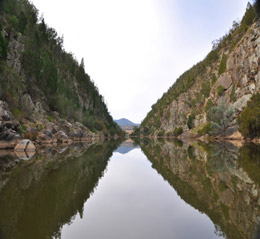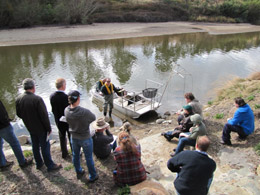ACT State of the Environment Report 2011
Accurate, timely & accessible information for the community regarding the condition of the environment, underlying pressures, and sustainability trends.
Sustainability Story: Improving river health- Upper Murrumbidgee Demonstration Reach Project
Download: Report Stories Improving river health- Upper Murrumbidgee Demonstration Reach Project.pdf
Over the past decades the health of the Murrumbidgee River has suffered serious decline, largely as a result of human activities such as water extraction, altered flow regimes, vegetation clearing, catchment erosion, and placement of weirs and unsuitable river crossings.
Weeds have invaded riverbanks, river flows are low, sand has built up in parts of the river channel and water quality is often poor. As a result, there are fewer native fish while introduced species such as European carp are thriving. In fact, carp now make up more than 80% of the fish stock; a situation widespread across the Murray-Darling Basin where native fish stocks are around 10% of pre-European settlement levels

Black Rock Gorge, near Bumbalong (NSW), although visually beautiful, only carp are caught here. (Photo courtesy of Mark Jekabsons, ESDD)
The Upper Murrumbidgee Demonstration Reach (UMDR) project is a good example of what can be achieved through collaboration. The project is bringing together community groups, government, business and other organisations to improve river health and reinstate native fish populations in 100 river kilometres between Bredbo and Casuarina Sands.
The UMDR project is paying special attention to improving riverbank health, increasing in-stream habitat, removing barriers to fish movement, and supporting improved local river flows. A Carp Reduction Plan has also been developed for the UMDR region to assist in managing this pest species.
The current work in the demonstration reach will help minimise the effects of sand in the river channel adjacent to the Lanyon property in the ACT. The work will help native fish swim through this very shallow stretch of river and provide important fish habitat. If successful, the approach used at Lanyon may be suitable for other sand affected river sections.

Demonstrating electro-fishing - one of the key tools used for fish monitoring in the UMDR. (Photo courtesy of Luke Johnston)
Through the initiative, the project team aims to increase understanding of river health issues and encourage local communities to get involved in scientific studies and community-based river health monitoring to measure progress over the coming decade or so.
This river rehabilitation initiative stems from the Murray Darling Basin Authority's Native Fish Strategy which aims to improve fish stocks to 60% of pre-European levels across the basin within the next 50 years. The UMDR project team is made up of representatives of ACT and NSW Governments, regional Natural Resource Management bodies, community groups, corporate organisations and local research institutions.
To find out more head to the website upperbidgeereach.org.au






Share this page: